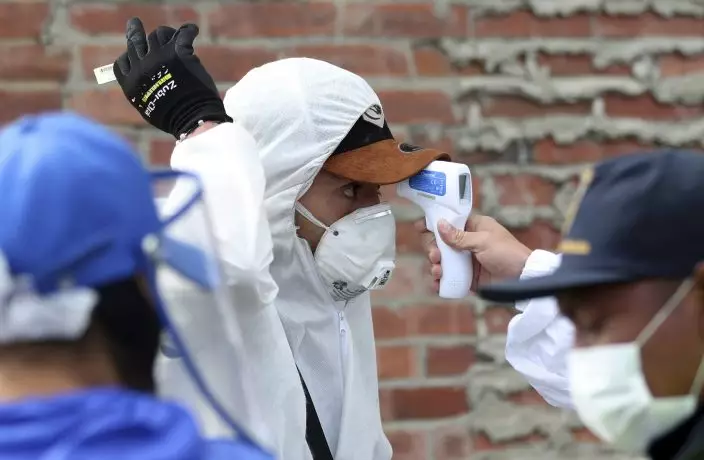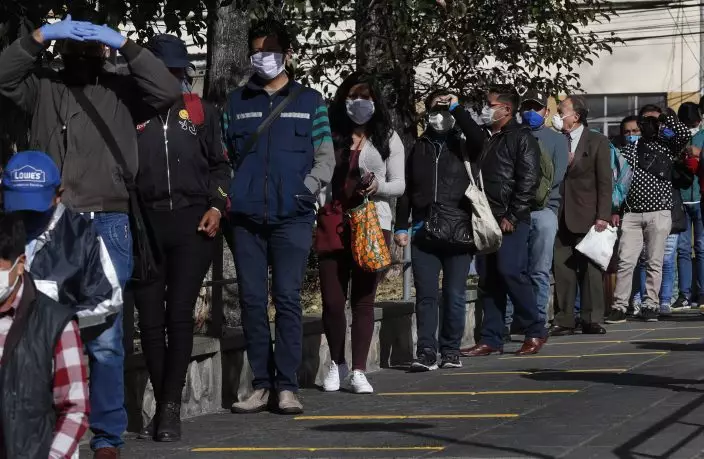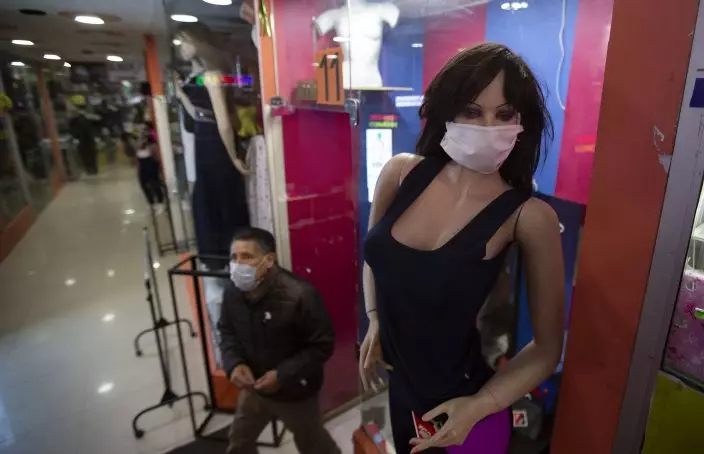South American countries on Monday began easing COVID-19 restrictions even as the region hurtles toward its viral peak, disregarding the example set by European nations that were battered earlier by the virus.
Some of Brazil’s hardest hit cities, including the jungle metropolis Manaus and coastal Rio de Janeiro, are starting to allow more activity. Bolivia’s government authorized reopening most of the country and the government of Venezuela’s Nicolás Maduro unwound restrictions. Ecuador’s airports were resuming flights and shoppers returning to some of Colombia’s malls.
Rolling back measures runs counter to Europe's approach of waiting for the worst to pass before resuming activity, and South America trails much further behind on its viral curve. Even European nations that lifted restrictions earliest in their respective outbreaks – the U.K. and Russia - did so only after clearing their initial peaks.

Commuters wearing face masks due to the new coronavirus pandemic ride buses in Caracas, Venezuela, Monday, June 1, 2020. After two and a half months of COVID-19 related quarantine, some industries are allowed to reactivate under a scheme of five days' work and 10 days rest. (AP PhotoAriana Cubillos)
The executive director of the World Health Organization’s emergencies program, Mike Ryan, expressed concern over South America's climbing contagion, telling reporters May 22 it has “become a new epicenter for the disease.” Data from the WHO’s Pan American Health Organization shows the region's seven-day rolling average of new cases continues rising, due in large part to Brazil, which accounts for more than half the total.
Manaus, the Amazon rainforest's largest city, was the first Brazilian metropolis whose health care system collapsed. For weeks, overwhelmed intensive-care units were unable to admit patients, deaths at home surged and a city cemetery buried bodies in mass graves.
Such burials continue, yet the capital of Amazonas state on Monday began loosening its clamp on non-essential businesses. Amazonas registered 818 new COVID-19 cases Sunday, bringing the total number of cases above 40,000. There are more than 500,000 confirmed cases in Brazil, the second most in the world, and experts believe the true toll to be much higher due to insufficient testing.

Workers of the Corabastos market, one of Latin America's largest food distribution centers, takes the temperature of drivers due to the presence of the new coronavirus, in the Kennedy area of Bogota, Colombia, Monday, June 1, 2020. Bogota's Mayor Claudia Lopez said Saturday that starting June 1, this working-class area will be under strict quarantine while COVID-19 cases continue to rise. (AP PhotoFernando Vergara)
Rio de Janeiro, the Brazilian city with the second-most cases after Sao Paulo, on Monday announced it would begin gradually relaxing restrictions the following day. Already a city in its metropolitan region, Sao Joao de Meriti, started allowing salons, auto mechanics, and hotels to operate on Monday.
“Brazil tends to look at Europe, and the problem is that there they did one or two months of strict quarantine and are now reopening,” said Renato Mendes Coutinho, a specialist in mathematical biology at COVID-19 BR Observatory, an independent group of more than 50 Brazilian researchers. “The difference is that the lockdown they implemented and the restriction measures were much more efficient and thorough.”
Ecuador was one of the first South American nations slammed, with grim scenes of people leaving corpses outside their doorsteps in Guayaquil through March and April. The nation’s caseload continues to surge, yet its airport will resume international flights on June 3, according to Nicolás Romero, the airport’s spokesperson, though he said arriving passengers must spend 15 days in quarantine, without specifying how such quarantine will be enforced.

A worker at the Corabastos market, one of Latin America's largest food distribution centers, takes the temperature of a man amid COVID-19 restrictions in the Kennedy area of Bogota, Colombia, Monday, June 1, 2020. Bogota's Mayor Claudia Lopez said Saturday that starting June 1, this working-class area will be under strict quarantine while COVID-19 cases continue to rise there. (AP PhotoFernando Vergara)
The airport in capital, Quito, recorded its first flight in 80 days on Monday, and flights to Miami and Houston will take off on June 4.
“It has just been one flight so far, but the important thing is the message it gives, of flying safely,” Luis Galárraga, the airport’s spokesperson, told The Associated Press.
Across Ecuador’s border, Colombia has shut the international airport in its capital, Bogotá, until September and locked down an entire working-class district home to 1.5 million people. But in the nation’s second city, Medellin, malls threw open their doors on Monday, though checking customers' temperatures upon entry.

Wearing masks to prevent the spread of the new coronavirus, the Sanchez sisters Silvana, left, Maria, second left back, Luisa, second right front, and Brittany stand in from of their home in Puente Piedra shantytown on the outskirts of Lima, Peru, Monday, June 1, 2020. (AP PhotoMartin Mejia)
Medellin’s Mayor Daniel Quintero highlighted that the city registered no COVID-19 deaths in the prior 30 days. The national death toll, however, continues rising.
Marcos Espinal, director of PAHO's Department of Communicable Diseases and Health Analysis, said by phone that reopening too soon could cause harm in certain places that aren’t yet ready.
“If you’re in the middle of the epicenter, we don’t recommend to open,” Espinal said from Washington. “People’s lives are precious, and there shouldn’t be any negotiations of that.”

Commuters wearing masks as a precaution against the spread of the new coronavirus line up, keeping distance, at a cable car station in La Paz, Bolivia, Monday, June 1, 2020. The cable restarted operations, with a reduced number of passengers per gondola, as the total lockdown begins to ease. (AP PhotoJuan Karita)
Venezuela on Monday allowed barbershops, beauty salons, auto shops, construction sites and banks to begin operations, along with other sectors. The nation is dialing down restrictions because it has reported relatively low COVID-19 impact: 1,510 cases and 14 deaths. Experts have roundly criticized Venezuela’s data as suspicious.
Bolivia on Monday instituted a so-called “dynamic quarantine” in most of the country, keeping parks and shows shuttered while resuming work, commerce and public transport, even as contagion continues rising.
The government’s public works minister, Iván Arias, suggested Monday that men shave their beards and mustaches to prevent infection. The Health Ministry’s epidemiological director, Virgilio Prieto, offered less optimism about recalibrating the nation’s quarantine, admitting it “could bring about an explosion of the new coronavirus.”

Pedestrians wearing face masks amid the new coronavirus pandemic walk in La Paz, Bolivia, Monday, June 1, 2020. After more than two months of quarantine the government approved the reopening of some commercial activity and public transport, as the total lockdown begins to ease,. (AP PhotoJuan Karita)
Across the ocean, in Europe, nations have debated reopening even after passing their contagion peaks. Britain only began easing lockdown once new deaths, hospitalizations and infections had clearly topped out. Still, some public health experts believe the government has acted too soon and there will likely be a new rise in infections.
Russian officials say that the nation is now past its peak, making it safe to gradually ease restrictions, even though some experts warn that the significant daily increase of about 9,000 cases makes it dangerous to do so quickly. On Monday, non-food retail stores, dry cleaners and repair shops reopened in the Russian capital that accounted for about half of the nation’s caseload.
Having seen first-hand the worst of the virus’ damage in Europe, Jesús Gómez-Cardeñes, an epidemiologist and associate professor at Spain’s University of Zaragoza, looks on South America's rush to reopen with concern.

A mannequin wearing a face mask stands at the entrance of a women's clothing store in La Paz, Bolivia, Monday, June 1, 2020. After more than two months of quarantine to curb the spread of the new coronavirus the government authorized the restart of public transport and several industrial and commercial activities. (AP PhotoJuan Karita)
“Opening their doors when we have recent growth in the number of daily cases is something that could be, or is, a catastrophe,” he said.

A passenger wearing a mask and face shield as a precaution against the spread of the new coronavirus, looks from the window of a taxi in La Paz, Bolivia, Monday, June 1, 2020. After more than two months of quarantine, the government approved the reopening of some commercial activity and public transport, as the total lockdown begins to ease,. (AP PhotoJuan Karita)


